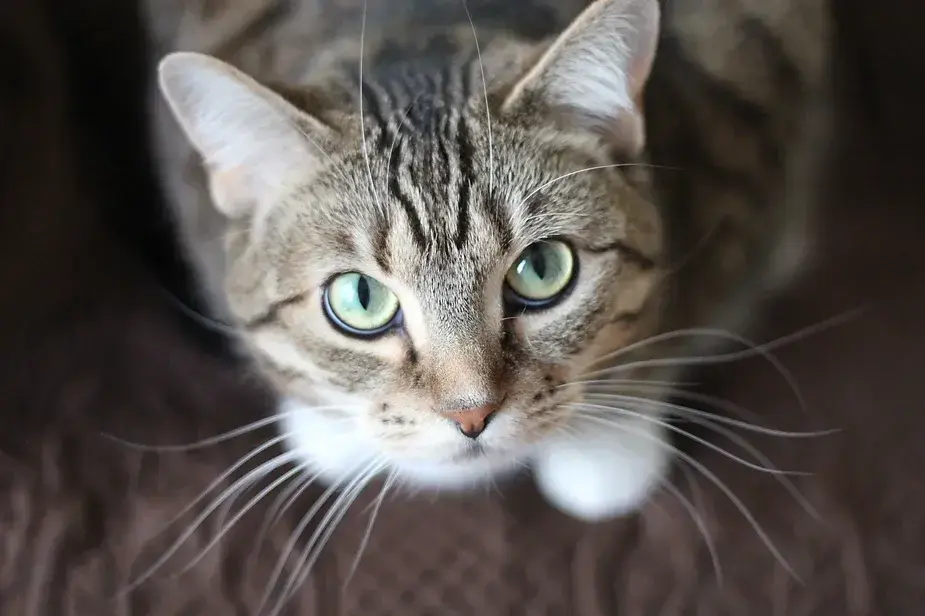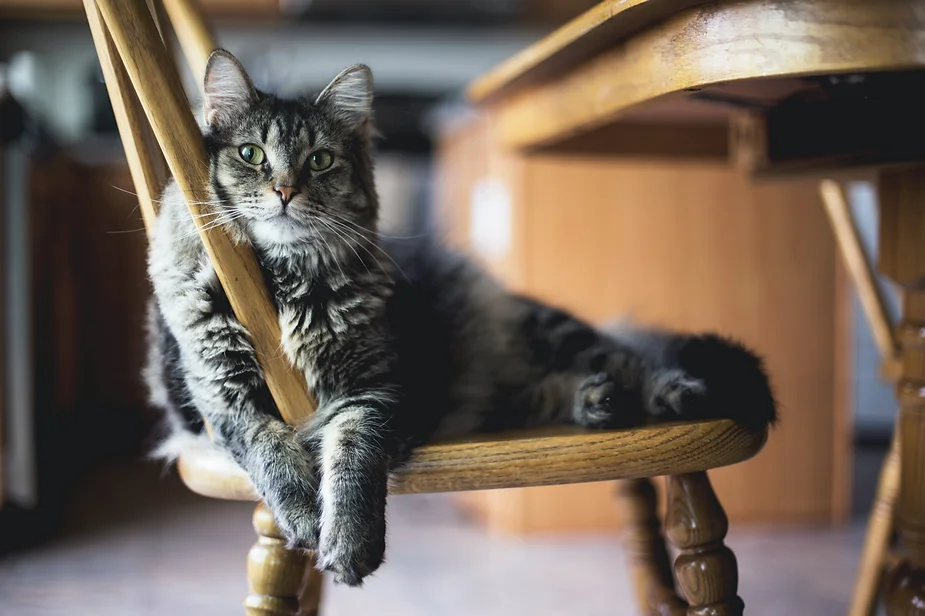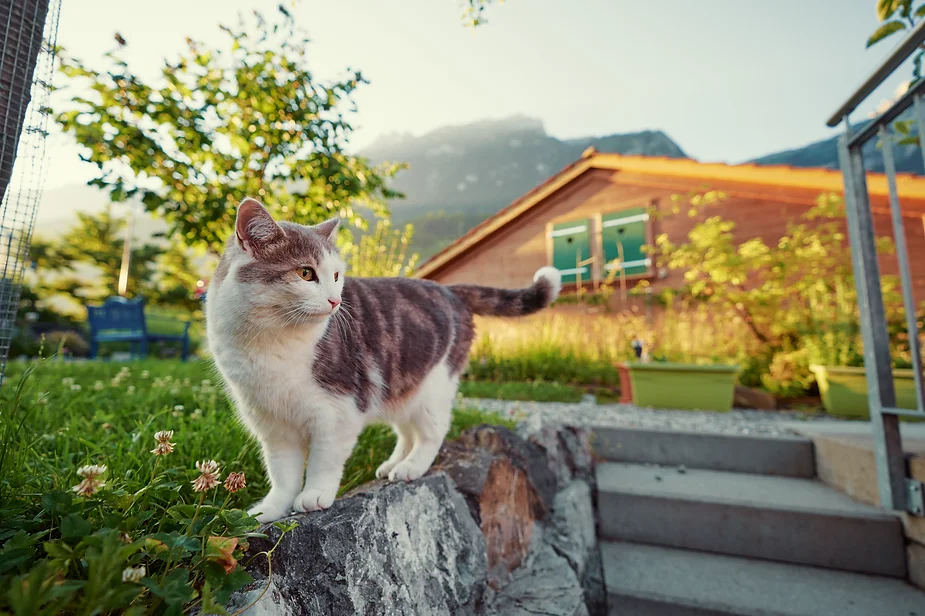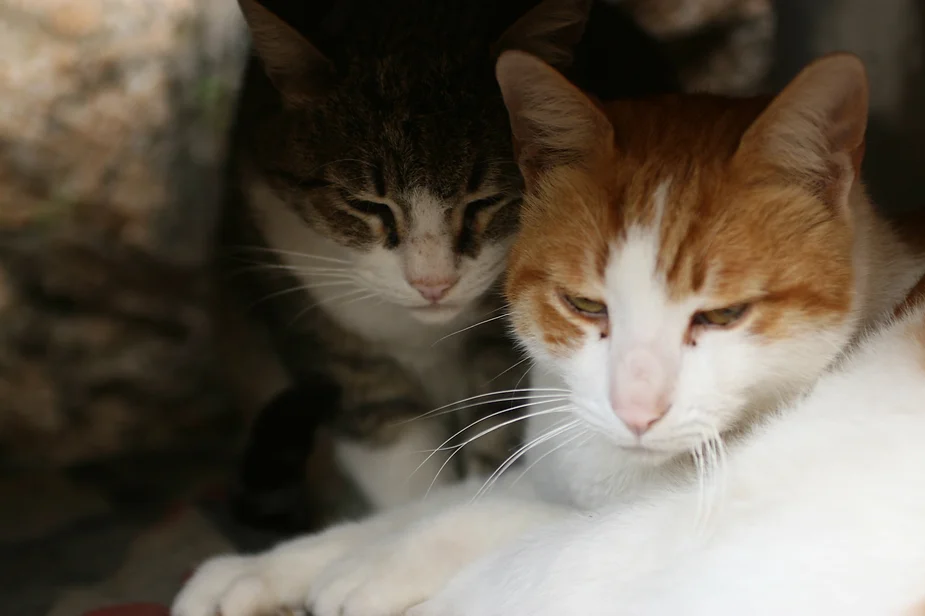
Cat Training 101
Cats are great companions and make amazing pets. They will want to spend time with you and will thank you in soft purrs.
What are Cat Whiskers?
Whiskers are the long, thick, flexible hairs on a cat's face. These hairs are located in horizontal rows on the puffy area between the top corners of your cat's mouth and the outer edges of his nose.
- Whiskers should never be cut or trimmed
- Whiskers are extremely sensitive to air movement so the cat can detect an objects presence from a distance. This helps a cat slink its way through a room at night and not bump into anything
- When a cat is angry or feels defensive, the whiskers will be pulled back. The whiskers will be more relaxed and pushed forward when the cat is happy, curious and content.
- A cat's whiskers are roughly as wide as his body and determine the smallest gap he can comfortable fit through.
My cat is avoiding the litter box
If your cat is avoiding the litter box you need to learn the cause of this behavior before it can be corrected. Is the litter box big enough, clean enough? Is your cat older? Do you have the right type of litter? Is your cat sick? Questions! Questions! Questions! Here are a few suggestions to help:
- Consult your vet and rule out any medical issues like bladder or urinary infections. Urinary tract infections, cystitis or feline lower urinary tract diseases are all very common reasons why your cat could be avoiding his litter box. A cat with a painful urinary infection may develop a negative association with the litter because they don’t understand what is causing the pain and discomfort.
- Position your cat litter box in a quiet private area of your home where your cat can do his business in private. Your cat may not want to toilet in the busiest area of the house. Cats dislike toileting and feeding in the same location.
- If you have moved the litter box, show your cat where the new location is. If your cat is elderly, keep the litter box in a more easily accessible location.
- Can your cat access his litter box? Elderly, arthritic, or unwell cats may find climbing into a high-sided tray difficult and need a lower one.
- Does your cat feel comfortable using the litter box? Your cat may dislike the type of litter you have chosen. What looks and smells good may not be ideal for your cat. When changing the brand of litter, combine the old and the new litter for a week or so. A covered litter box can provide a more secure private area.
- Most cats do not like to use a dirty litter box so ensure you scoop it daily and clean it on a regular basis. Replace the scooped litter with a sprinkling of fresh new litter. All litter boxes need to be completely emptied and thoroughly cleaned regularly. Always add fresh new litter.
- Using tray liners can upset some cats by the plastic scent or the sensation they get when their claws are scraping the litter.
- In multi-cat households some cats will happily share a litter box, but if the cats are not close friends this can cause stress. If the litter box is already occupied your cat might feel forced to go elsewhere. They don’t like to wait!
- Make sure you have at least one box per cat and that all boxes are kept very clean.
Cleaning the litter box
Regardless of what type of litter or litter box you decide to purchase, you need to keep all litter boxes fastidiously clean to encourage them to use it without fail.
The frequency with which your cat uses the litter box and the number of cats that use the same litter box will determine how often the litter should be changed. Make sure that you are cleaning it regularly. Many cats are unwilling to use a soiled box.
- Dispose of all used litter and thoroughly clean the box at least once a week.
- Wash with plain hot water and avoid any cleaning product that are scented or contain potential toxins.
- Keep the box very clean to eliminate the lingering smell of urine and feces.
What type of litter is best?
Use unscented clumping litter with no odor control additives and as large a litter pan as you have space for. The bigger the better! Your cat is an individual with its own litter box preference regarding texture, smell and feel of litter along with litter box size and location.
- If you need to change the type of litter, do so over a period of about a week, and proceed by swapping a little of the current one with the some of the new product until the box contains only the new type.
- Always use a cat litter that has been tested as safe in case your cat accidentally ingests some litter. This is likely to happen because cats will lick their paws and fur.
- Some cats simply prefer the scent or texture of certain products, and some soak up urine better or are easier to cover feces with.
- Use a litter with no odor control in order to provide your cat with as natural environment as possible to do his business.
There is an amazing array of cat litter varieties available:
- Clumping
- Unscented or scented
- Organic litter
- Corn and wheat based litter
- Newspaper based litter
- Crystal or silica based litter
- Clay litter
What if my cat uses my indoor plants for a toilet?
Cats find the soil in our indoor plants extremely enticing and may use them as a toilet instead of the litter box or going outside.
- Soil is absorbent, easy to dig, and houseplants are usually located in convenient places where the cat feels safe.
- Cover up the soil with large decorative rocks or wire mesh so your cat learns that this area is no longer available for relieving themselves.

What if my cat scratches my furniture?
Scratching is part of natural feline behavior and if your cat is scratching furniture, you will need to provide them with other options to divert their attention.
Cats naturally scratch to sharpen their claws, to mark its territory or just for the satisfying feeling. Redirect your cat's natural need to scratch by offering satisfying scratching alternatives. You'll both be happier.
- Cats like to scratch different surfaces and prefer a scratching post made out of carpet, sisal, or a corrugated cardboard pad designed for scratching.
- Make sure the scratching post is secure, stable and strong enough to withstand energetic playing, scratching, climbing and jumping.
- A vertical post should be taller than your cat when standing on hind legs, because this will allow them to exercise the muscles of their body and satisfy scratching urges.
- Spray or rub catnip on the post to encourage your cat to enjoy and play. Try a cat wand or string to lure your cat to swipe or pounce on the post.
- Talk to your pet specialist at Buckerfield's Country Stores for small plastic caps that can be fitted over your cat’s nail to prevent further damage from scratching. These last 4-6 weeks and prevent your cat from damaging your furniture.
What if my cat hunts birds?
Cats are fantastic hunters and have great physical agility to detect prey and are a big concern for nature enthusiasts. Here are some ideas to help discourage them.
- If you encourage birds into your yard by feeding them, try using a tall platform feeder, or use feeders that can be hung up, away from places where your cat may hide and ambush them.
- Give the birds warning to escape by putting a bell on your cat’s collar. As your cat approaches, the birds will hear a jiggling sound and can escape to safety.
What if my cat eats grass?
They rarely eat more than occasional small amounts, and enjoy the taste and texture. Cats love it!
- Cats usually prefer wheat or oat grass to regular lawn type grass. These lush green sprouts are nutritious and delicious and easily grown from seed.
- Cat grass is a source of natural fiber that will help your cat pass hair through the digestive system and prevent hairballs from forming.

My cat loves catnip
Cats go crazy over catnip! Catnip emits scents that stimulate your cat and cause them to display ecstatic responses, such as rubbing, rolling, leaping, and purring.
- Fresh catnip fresh grown or dried will get your cats' approval and attention.
- The chemical they are responding to is called nepatalactone.
- This crazy reaction last about 15 minutes.
- You can rub it on scratching posts and toys, or just let him eat a small amount and watch the burst of activity that catnip provides.
- For extra fun, grow your own, and make a few catnip "mice," using purchased baby socks. Cat’s love cat nip!
Should you spay or neuter your cat?
Absolutely, you should have your cat spayed or neutered! Spayed and neutered cats generally have fewer health problems and a longer life expectancy. Most cats are healthier, happier and calmer if they've been spayed or neutered.
Animal shelters and rescue groups require cats to be spayed or neutered before they will allow them to be adopted.
Male cats that are not neutered have a tendency to roam if allowed outside and a habit of spraying strong smelling urine.
Adult cats can be safely spayed or neutered at any age, so even older cats should have this procedure done. Kittens should be spayed or neutered between four and six months of age. Females should definitely be spayed before their first heat!
Neutering a male cat
- The cat is placed under general anesthesia, and the testicles are removed through an incision in the scrotum. The incision is very small and stitches are usually not even necessary. He usually goes home the same day and returns to normal activities the following day.
Spaying a female cat
- The ovaries, fallopian tubes and uterus are removed after the cat is immobilized with general anesthesia. The abdominal area is shaved and the surgical wound usually only requires a few stitches.
- In most cases your cat will be able to come home the same day. Try to limited activity for two or three days until the stitches start to heal.
Do I need to brush my cat`s teeth
Yes! Brushing is one of the best ways to help keep your cat's teeth and gums healthy and tartar free and reduce gum disease.Try to brush your cat's teeth as often as possible.
- Use flavored cat toothpaste, a pet toothbrush or a finger toothbrush to make the job easier. Teeth cleaning pads and sprays are also available.
- Start cleaning your cat's teeth from as early an age as possible.
- Offer treats that are hard and crunchy to help remove tartar and keep teeth clean.
How many teeth does a cat have?
Kittens have 26 teeth, adult cats have 30. Kitten teeth begin to fall out around three months of age.
Using a cat flap to go outdoors
Practise and encouragement is the answer too training a cat to use a cat flap.
- Make sure door is at a comfortable height for your cat and the door wings easily.
- Place some tempting food on the far side of the door and gently push the cat through.
- Then open the flap and call the cat back. Repeat a few times and the cat will learn to operate the flap itself.
How to tell if your cat is sick?
Illness or injury can strike at any time, so it is important to keep an eye open for any unusual behaviour in your pet that might indicate all is not well. If in doubt, always check with your vet. Things to look for:
- Get to know your cat’s character and understand how they normally behave.
- While grooming your cat, look for any lumps, signs of fleas or ticks, mites or lice.
- Changes in eating or drinking habits.
- Any change in normal behaviour or appearance.
- Abnormally raised fur.
- Diarrhoea or constipation.
- Discharge, redness or inflammation of the eyes.
- Clear wax in the ear in normal, a dark brown waxy deposit may indicate ear mites.
- Persistent vomiting.
How long will my cat live?
If you provide a balanced diet, the correct inoculations and regular check-ups, there is no reason why your cat should not live a long and happy life. Twenty years in not unusual!
- Cats traditionally live longer than dogs.
- Most cats live for about 14-16 years with proper care and nutrition.
When is my cat a senior cat?
From the age of 10-12 years a cat may begin to show signs of growing old.
- Internal organs may not work as well and joints become stiffer.
- Cats become less active and less playful.
- Neutered cats have a longer lifespan than those unneutered.

Grooming
Cats are meticulous self-groomers, and devote a large part of their waking hours to grooming themselves.
- The cats tongue has a rough surface which combined with saliva, helps to remove grit and sticky substances from the fur.
- Areas they cannot reach directly with their tongue are cleaned by licking the front paws and are using them like a wash cloth.
- As the coat dries the cat nibbles the fur back into place with its small incisor teeth and removes any foreign matter that the washing process failed to dislodge.
- The back claws act like a wide tooth comb and remove larger objects from the coat. The front paws stimulate a slightly oily secretion from glands around the head, and transfer them to other parts of the body during grooming. This can then be used to mark his territory.
Regular brushing prevents fur from matting, removes loose hair and reduces hairballs, especially for long-haired cats.
How often do cats shed?
- An outdoor cat sheds his coat once a year in the spring.
- An indoor cat tends to shed throughout the year and hair loss is hardly noticed, except on carpets, floors and furnishings.
What are hairballs?
When self-grooming at any time of the year, the cat dislodges loose fur and some of it is swallowed. This gradually builds up into a fur ball which can eventually solidify into a pellet in the cat’s intestine. Hairballs develop as a result of your cat’s healthy and fastidious grooming routine.
- Most cats automatically bring up a small fur ball every few days, but sometimes one can become stuck, causing loss of appetite and a rundown condition. Long haired cats are more at risk.
- When your cat grooms himself, tiny hook-like structures on his tongue catch loose and dead hair, which is then swallowed. The majority of this hair passes all the way through the digestive tract with no problems. But if some hair stays in the stomach, it can form a hairball. Ultimately, your cat will vomit the hairball to get rid of it.
- Hairballs in cats are more likely to appear in long-haired breeds, cats that shed a lot or who groom themselves compulsively.
Symptoms of Hairballs in Cats
It can be disturbing to watch or hear your cat eliminating a hairball. Some common hairball symptoms include hacking, gagging, and retching. Usually, your cat will then vomit the hairball in relatively short order.
If you notice the following hairball symptoms, be sure to contact your veterinarian, as they could indicate that a hairball has caused a potentially life-threatening blockage:
- Ongoing vomiting, gagging, retching, or hacking without producing a hairball.
- Lack of appetite, lethargy, constipation or diarrhea.
Hairball Remedies
Nothing can be done to totally prevent hairballs in cats, but there are things you can do to reduce the likelihood your cat will have hairballs or reduce their frequency.
Groom your cat regularly
Brush your cat regularly. When your cat grooms itself it digests excess hair which can form a hairball in the stomach. Removing shedding fur with a brush will help reduce the amount of loose hair that your cat swallows. The more fur you remove the less hairballs!
- Combing or brushing your cat on a daily basis can be an effective way to minimize hairballs, and it can also provide a fun way for you to bond with your cat.
- Long-haired cats that have mats or don’t like to be brushed should be taken to a professional groomer for a grooming and haircut.
Feed a hairball formula cat food
Consider switching to a cat food specifically made for hairball prevention. Many pet food manufacturers offer cat foods to reduce hairballs.
- These high-fiber formulas are designed to improve the health of your cat’s coat, minimize the amount of shedding, and encourage hairballs in cats to pass through the digestive system.
Use a hairball product
Purchase an over the counter hair ball remedy that will help your cat pass hairballs through the digestive tract.
- These products help your cat pass excess hair through their digestive system and into the litter box.
- If your cat refuses to eat the hairball remedy, try mixing it into their food or putting a small amount on their paw to lick off.
- Place a small patch of cat grass where your cat has access to it. Cat grass is another great source of natural fiber that will help your cat pass hair through his or her digestive system and prevent hairballs from forming.
Nail trimming
Claws are indispensable feline tools; cats use them to hunt, play, groom, exercise, mark territory and defend themselves.
- Cats naturally scratch to sharpen their claws and to keep them from overgrowing. Scratching helps keep claws in shape. And scratching just feels good!
- Nails should be trimmed only if needed.
- Take your cat to your veterinarian or pet groomer, and they can show you how to trim your cat’s nails.
Toys, Toys, Toys
Everyone knows how to play with a cat! Slowly move, twirl, rock or throw a toy and watch your cat chase it. How much fun is that!
- Irresistible toys for your cat include recyclable paper bags and cardboard boxes.
- Stock up on toy catnip mice, crinkly toys and balls of all kinds to throw and chase.
- Splurge on a great interactive toy.
- Many cats are crazy for catnip, and a dab of catnip will irresistibly lure cats to any toy, scratching post, or kitty tower. Fresh catnip is also a favorite treat for cats.
Have more questions? Visit your local Buckerfield's and we'll be happy to help!



